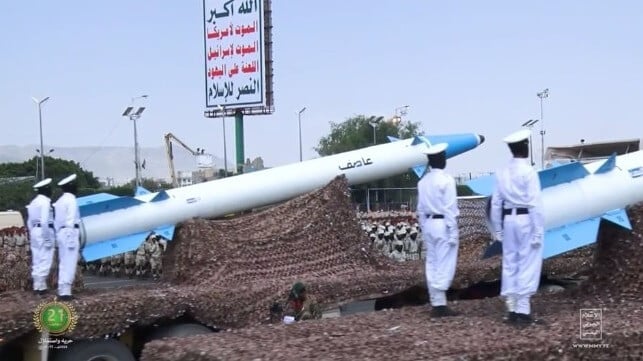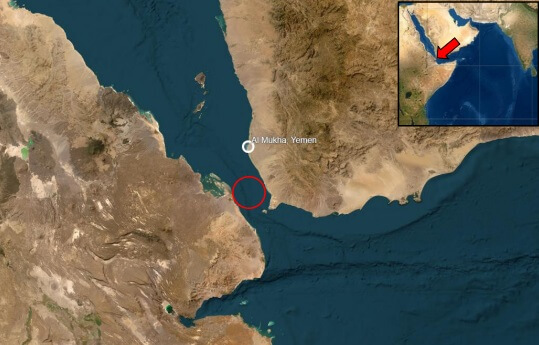Houthi Forces Attack Greek Bulker in Red Sea

Yemen's Houthi rebels have launched another attack on a merchant ship, ending a comparatively peaceful gap of 18 days in the Red Sea. The attack followed two days after Israel's long-expected airstrike on Iran, the Houthi organization's primary sponsor.
On Monday at about 1435 hours GMT, the master of a merchant ship reported an explosion near his ship. A second explosion followed at 1503, followed by a third at 1637. The vessel and the crew are reported safe and are continuing to the next port of call, according to the Royal Navy's UK Maritime Trade Operations (UKMTO). The multiple-strike pattern follows the recent Houthi practice of targeting a vessel repeatedly as it transits past the Strait of Bab el-Mandeb.
EOS Risk Group has identified the target as the 80,000 dwt bulker Motaro. The vessel's AIS signal was last detected southbound in the Red Sea on October 27, declaring the Chinese port of Changjiangkou as her destination.

Approximate attack location (UKMTO)
The Houthi group claims to target vessels connected to Israel and its allies, either by operational activity or ownership. Motaro is Greek-owned and operated, and her Pole Star AIS record shows no visits to Israel in the last three years.
On Monday night, a Houthi military spokesman confirmed an attack on the Motaro and also claimed unconfirmed strikes on the SC Montreal and Maersk Kowloon in the Arabian Sea. The spokesman claimed that the attacks were in retaliation for "the violation by the companies that own them of the decision to ban entry to the ports of occupied Palestine."
U.S. Central Command has yet to confirm any of the strikes. It was the first confirmed Houthi anti-shipping activity since U.S. Air Force bombers hit the militant group's underground missile storage facilities on October 17.
American security sources recently told the Wall Street Journal that Russia provides satellite targeting data to Iran, which Iranian agents pass on to Houthi leaders for operational use against Western shipping. Iran also provides most of the Houthi group's missile technology and is suspected of conducting on-scene intelligence gathering on the Houthis' behalf in the Gulf of Aden.
Report: Russia is Providing Targeting Data to Houthis for Attacks on Ships

An exclusive in the Wall Street Journal has confirmed that Russia has been providing details of ship movements to enable Houthi attacks in the Red Sea.
The middlemen between the Russians and the Houthis are the Iranians. A brigadier from the Islamic Revolutionary Guard Corps Quds Force sits on the Houthi Jihad Council as deputy to its leader, Abdulmalik al-Houthi. A second IRGC member also sits on the Council, with particular responsibility for drones and missiles.
The IRGC gets the intelligence to feed to the Houthis from its own sources, including long-range drones and Iranian naval vessels permanently on station in the Red Sea area. The Houthis also have their own reconnaissance drones and a fleet of fishing boats acting as spotters as well.
The Russian feed of intelligence to the Iranians, and thence to the Houthis, is well established.
In August 2022, a Russian Soyuz 2.1b rocket launched an Iranian intelligence satellite from Kazakhstan. The Khayyam satellite, jointly built and based on the Russian Kanopus-V imagery satellite, was placed in a 500-kilometer low earth orbit, and is now giving the Iranians access to one-meter resolution imagery, sufficiently accurate to use for targeting an area of a ship.
The Khayyam’s orbit allows it to visit any specific point of interest about four times a day, but then the satellite needs to be in position to download the imagery back to Earth. This limits the utility of the system in targeting moving targets such as ships. However, the Khayyam system is almost certainly being used in an intelligence-swap arrangement alongside Russia’s own Kanopus-V constellation of spy satellites, meaning that ship movement information available to the Iranians is likely to be much more up to date.
The Khayyam satellite is far more effective than the three satellites that the Iranians have built and launched themselves. One of these, the size of a washing machine, was described by US Space Command General John Raymond as “a tumbling webcam in space, unable to generate any useful intelligence.” Even so, the Khayyam is significantly less responsive and accurate than Western systems, and it is no surprise that the Houthis have attacked Russian ships in error on several occasions.
No comments:
Post a Comment